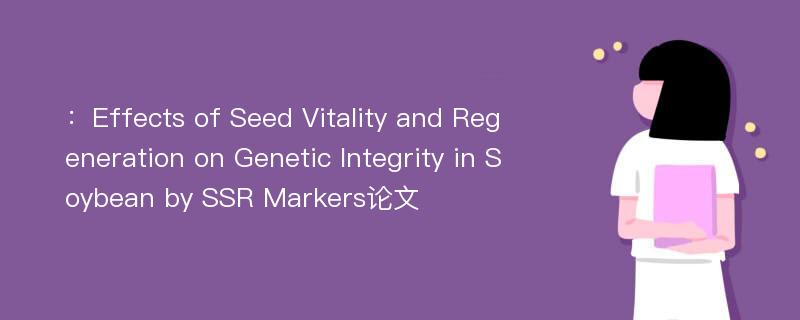
本文主要研究内容
作者(2019)在《Effects of Seed Vitality and Regeneration on Genetic Integrity in Soybean by SSR Markers》一文中研究指出:The seeds of Zhonghuang 18 were selected as a test material,and subjected to artificial aging treatment(0,112,154 and 196 d),obtaining four 4 populations,i.e.,G0-1,G0-2,G0-3 and G0-4,the germination rates of which were 98.0%,95.0%,81.0%and 79.0%,respectively.The four populations were reproduced twice in field,giving four populations of the first reproduced generation G1-1,G1-2,G1-3 and G1-4 and four populations of the second reproduced generation G2-1,G2-2,G2-3 and G2-4.The results showed that the number of alleles(Ae)per locus and genetic identity of all the treatment populations did not change significantly compared with the control population G0-1,and population G0-4 still shared 0.996 2 genetic identity with the control population,indicating that the genetic identity between the population with a germination rate of 79.0%and the control population was still high.The results of t test showed that populations G0-2,G1-1 and G2-1 showed number of alleles per locus(A),genetic diversity index(H)and Shannon index without significantly differences from the control population G0-1;populations G1-2 and G2-2 had the number of alleles per locus(A)significantly decreased;and the above genetic diversity parameters of populations G0-3,G0-4,G1-3,G1-4,G2-3 and G2-4 decreased significantly or very significantly.The results ofχ2test showed that there were almost no differences in the allelic frequency distribution between populations G0-2,G1-1 and G2-1 and the control populaiton G0-1;and populations G0-3,G0-4,G1-2,G1-3,G1-4,G2-2,G2-3and G2-4 differed in allele frequency distribution,and the lower the vitality level,the greater the differences.Compared with the control population G0-1,populations G0-2,G1-1 and G2-1 had no significant changes in number of rare alleles,while populations G0-3,G0-4,G1-2,G2-2,G1-3,G1-4,G2-3 and G2-4 decreased significantly in number of rare alleles.The above results showed that compared with the control population,the progeny populations reproduced from the population with a germination rate of 98.0%had significant changes in genetic diversity and number of rare alleles,while the values of the progeny populations reproduced from populations having germination rates of 81.0%and 79.0%,respectively,decreased significantly,and the number of alleles per locus and number of rare alleles of the progeny populations reproduced from the population with a germination rate of 95.0%began to decrease.The decline in viability has a greater effect on the genetic structure of soybean germplasm populations than reproduction generation.It is recommended that the germination rate standard for regeneration of soybean germplasm with an initial germination rate of 98.0%should not be lower than 81.0%.
Abstract
The seeds of Zhonghuang 18 were selected as a test material,and subjected to artificial aging treatment(0,112,154 and 196 d),obtaining four 4 populations,i.e.,G0-1,G0-2,G0-3 and G0-4,the germination rates of which were 98.0%,95.0%,81.0%and 79.0%,respectively.The four populations were reproduced twice in field,giving four populations of the first reproduced generation G1-1,G1-2,G1-3 and G1-4 and four populations of the second reproduced generation G2-1,G2-2,G2-3 and G2-4.The results showed that the number of alleles(Ae)per locus and genetic identity of all the treatment populations did not change significantly compared with the control population G0-1,and population G0-4 still shared 0.996 2 genetic identity with the control population,indicating that the genetic identity between the population with a germination rate of 79.0%and the control population was still high.The results of t test showed that populations G0-2,G1-1 and G2-1 showed number of alleles per locus(A),genetic diversity index(H)and Shannon index without significantly differences from the control population G0-1;populations G1-2 and G2-2 had the number of alleles per locus(A)significantly decreased;and the above genetic diversity parameters of populations G0-3,G0-4,G1-3,G1-4,G2-3 and G2-4 decreased significantly or very significantly.The results ofχ2test showed that there were almost no differences in the allelic frequency distribution between populations G0-2,G1-1 and G2-1 and the control populaiton G0-1;and populations G0-3,G0-4,G1-2,G1-3,G1-4,G2-2,G2-3and G2-4 differed in allele frequency distribution,and the lower the vitality level,the greater the differences.Compared with the control population G0-1,populations G0-2,G1-1 and G2-1 had no significant changes in number of rare alleles,while populations G0-3,G0-4,G1-2,G2-2,G1-3,G1-4,G2-3 and G2-4 decreased significantly in number of rare alleles.The above results showed that compared with the control population,the progeny populations reproduced from the population with a germination rate of 98.0%had significant changes in genetic diversity and number of rare alleles,while the values of the progeny populations reproduced from populations having germination rates of 81.0%and 79.0%,respectively,decreased significantly,and the number of alleles per locus and number of rare alleles of the progeny populations reproduced from the population with a germination rate of 95.0%began to decrease.The decline in viability has a greater effect on the genetic structure of soybean germplasm populations than reproduction generation.It is recommended that the germination rate standard for regeneration of soybean germplasm with an initial germination rate of 98.0%should not be lower than 81.0%.
论文参考文献
论文详细介绍
论文作者分别是来自Agricultural Biotechnology的,发表于刊物Agricultural Biotechnology2019年01期论文,是一篇关于,Agricultural Biotechnology2019年01期论文的文章。本文可供学术参考使用,各位学者可以免费参考阅读下载,文章观点不代表本站观点,资料来自Agricultural Biotechnology2019年01期论文网站,若本站收录的文献无意侵犯了您的著作版权,请联系我们删除。
